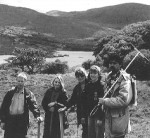The landscapes of Ireland and New England give the first-time visitor very different impressions. Lush green fields and ragged bogland dominate the Irish landscape, while deep forests and occasional stony fields are the trademarks of New England. Agriculture is a vital part of the Irish economy and countryside, while New England's prime agricultural period lies a century in the past. Plantation forestry using exotic conifers is a very small but rapidly growing force in Ireland, while the vigorous reclamation of abandoned agricultural lands in New England by native mixed forests is nearly complete.
Yet there is a common thread through the stories of these two regions-long-term human use of the land. This is the central theme for a joint program between the Harvard Forest LTER, the University of New Hampshire (UNH) and University College-Dublin (UCD). With support from the LTER-International Program and NSF’s Office for International Programs, Dr. John Aber from HFR and UNH and Dr. Ted Farrell of UCD have drawn students and colleagues into the comparative study of landscapes in Ireland and New England.
The program was initiated during a two-month summer leave spent by Dr. Aber in residence at UCD hosted by Dr. Farrell. “It is impossible to spend any time in Ireland and not be struck by the central importance of history to every discipline,” Dr. Aber says. “While we are just beginning to recognize the role of human history in every North American landscape, Ted Farrell was describing 500-1000 year histories of landscape change against a backdrop of human histories going back 4000 years and more.” Dr. Farrell has also studied a recent and important addition to the landscape--plantation forestry. As Dr. Farrell tells it, “In the mid-1800s, specimen estate plantings demonstrated the potential of exotic conifers in a country with no native coniferous forest tree species. Growth rates in plantations established in this century have shown that, especially for certain, conifers from the coastal forests of the northwestern U.S., production was far in excess of that in the coniferous forests of Central Europe and Scandinavia.”
This, together with the availability of surplus agricultural land and Ireland’s clean air, has given rise to European Union-supported programs to encourage the establishment of commercial coniferous forests on marginal agricultural sites.
Because of the growing importance of forestry, a first project between the two institutions (carried out largely by Christy Goodale, currently a Ph.D. student at UNH) was a combination GIS/modeling effort to predict potential forest growth for Ireland. Christy spent a summer in Ireland working with Ted Farrell, Dr. Jim Collins, a soil scientist at UCD, and Ph.D. student, Julian Alierne. Combined with a return visit by Julian to UNH, a 1 km resolution GIS containing important climate and soil variables was developed and used to drive a simple forest growth model for Sitka spruce, the most important plantation species in Ireland. Extending a model developed for New England to Irish conditions was a valuable experience, according to Christy. “The New England model did not include the effects of wind stress, saturated soils, or phosphorous limitations, all of which can be more important in Ireland than New England.”
This basic GIS also is proving useful for a new project to set critical loads for pollutants to sensitive ecosystems, funded by the Irish government. “The critical loads concept,” Julian pointed out, “was developed to produce ‘effects based’ emission control. It indicates the maximum level of pollution which is compatible with the sustainability of an ecosystem. The objective of the current project is to establish best estimates of critical loads and their excedances for the most important pollutant-receptor combinations in Ireland-based on current methods and the best available data. The basic GIS has been a valuable starting point for a national critical loads database.” Dr. Aber is technical advisor to this program.
Continuing work is focusing on land use effects on soils. Dr. Farrell has travelled to UNH twice to visit possible research sites. Deirdre Cunningham, a Ph.D. student in soils at UCD, spent this past spring at UNH studying local ecosystems and comparing effects of forest clearance on soils in Ireland and New England. Maggie Soulia and Barry Lefer, graduate students at UNH spent most of this summer in Dublin. Maggie is measuring N cycling rates in adjacent woodlands and fields in the west of Ireland for comparison with her master's thesis results from an abandoned farm in Maine.
Dr. Aber and Dr. Farrell agree that this exchange of people and ideas has strengthened their individual programs. “Testing ideas beyond the range of your own experience is critical,” Dr. Aber says, “and the personal experiences and goodwill developed have been wonderful.”
John D. Aber Complex Systems Research Center Institute for the Study of Earth, Oceans and Space, University of New Hampshire, Durham, NH 03824 USA
John.Aber@unh.edu
TEL: 603/862-3045
FAX: 603/862-0188

 Enlarge this image
Enlarge this image